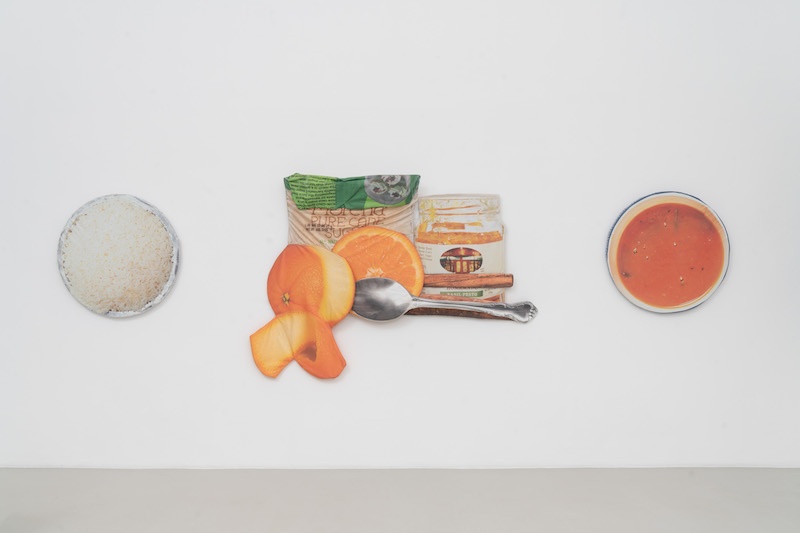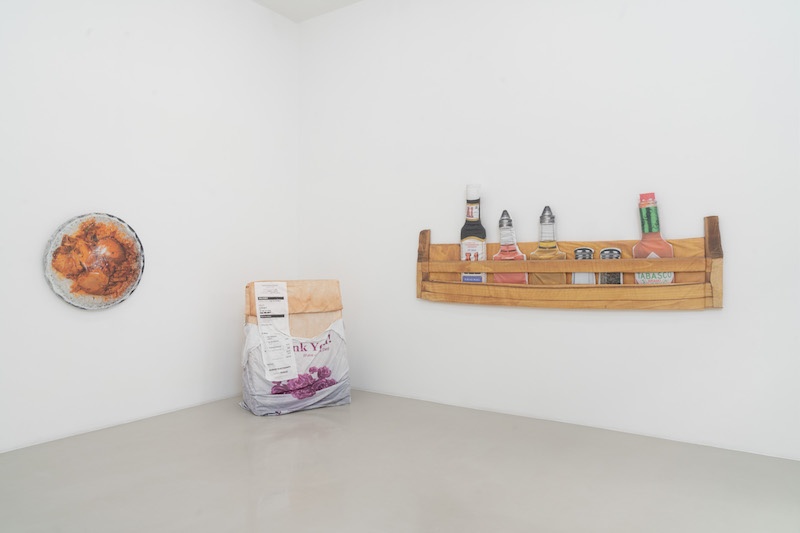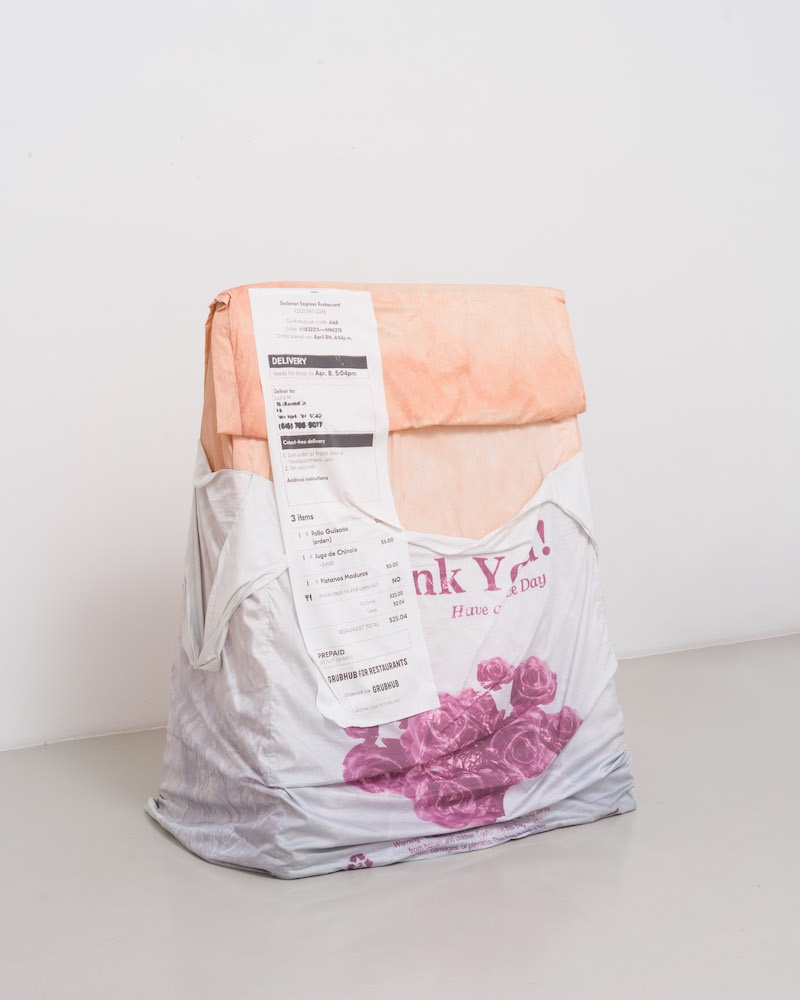As told to Eva Recinos, 2673 words.
Tags: Art, Process, Identity, Focus, Inspiration, Beginnings.
On doing right by your work
Conceptual artist Lucia Hierro discusses the value of getting to know yourself, the challenge of staying present, and the studio as a sacred place.
I read that your dad had a recording studio and that your mom has also been part of your practice as well in terms of sewing. I’d love to know more about that.
My family is in the arts via music and those are sort of the beginnings of my curiosity towards art. We moved to the Dominican Republic for a while, and after I came back and started high school in New York, like junior year of high school, I got really serious about art and making that decision. It wasn’t until visiting a few artists studios—I got to visit Miguel Luciano’s studio and Juan Sanchez my senior year of high school, with the Cooper Union Saturday Program—that I realized you could weave in parts of yourself into the work. Parts of your family history, parts of your own personal history, into works. And that was really exciting to me.
Then there was a rude awakening. I was always a strong student academically, and so I knew that I wanted to pursue an academic side of art making and it felt that most of my favorite artists had…there was something about going to a place where your peers are people that are just as serious about this life decision, sharing in that space. It felt sacred. I thought academia was always a part of the journey and quickly found out, while I was there, how rare my perspective, who I was, was within the academic context. That provoked me. It was a challenge. It was a thing that I wanted to take on.
Working with my mom came after school. It was a moment of realizing that I really needed to learn a thing that I had been putting off for a long time, which was learning how to sew—which was part of the origins of how we moved to the United States, how my mom’s family came to the US.
I’d love to go back to this moment of a “rude awakening” about your place within academia and within art making. You did go on to get your MFA from Yale School of Art. How did you keep yourself motivated to say, “Okay, I’m going to keep going with what I’m doing and I’m going to keep staying in these academic spaces.”
I never saw it as “we don’t belong.” These are places that yeah, maybe initially, were not designed with us in mind. We certainly had to position ourselves in a way to change the program because every cohort brought with it its changes or its set of needs. Art students shape programs. I think it’s a mistake to think of ourselves as empty vessels coming in and getting information. It’s an exchange that happens—and it’s a give and take between professors and students. What’s the conversation now might not have been the conversation when these professors were in school. All of the conversations are valid, so how do we adapt to what a certain class needs and what conversations need to be had, and how? Who are we inviting to have those?
I knew that it was going to be tough because, mostly, the knowledge wasn’t there, or the interest in wanting to know things outside of the classic Western canon. We get very comfortable because it’s easier to just have a set thing like, “Well, Modernism started here and this started here and these are the designated players in minimalism, and this and this and this.” It’s easier to memorize, it’s easier to pull from. It gets more challenging when you’re in a school where it’s an international student body and then each student is, like I said, bringing in their needs and they’re going, “I’m quoting my Japanese background” or “I’m quoting a design aesthetic that exists within the architecture of my country or something.” And unless you live there, you don’t really know.
I’m like, “Well, I’m from New York, but I’m from a very specific neighborhood in New York,” and if someone’s not from there, it was very difficult to explain it. I’m not anti-the old white men in the canon. I’m in conversation with them. I position myself as someone that’s like, “If they’re no longer with us, I’m having conversations with them in the studio.” I’m arguing with them as if we were in a bar together because these are my people, whether they like it or not. I really had that as motivation to do the thing, to always be really ambitious, to push the work, to always do what was right by the work. And not let anything dictate it—not let markets or current political conversations dictate the work.
Thinking about that idea of blocking everything out or trying to keep focused, do you feel like that’s something that has gotten easier over the years? Are there routines that are important to you, or patterns you try to break?
Usually, I don’t have time for a lot of openings. That’s a thing that I had to realize when I found a lot of social engagement straining. I think so much of making work is getting to know yourself really, really well. What works for you? What drains your energy? What gives you energy? What inspires you? What doesn’t? Or what types of people you like around. What bothers you? What sounds bother you? All of that. When those things are off, I feel it. I feel it in the work — or the work isn’t coming with fluidity. If my diet’s off, or I’m not going for walks or I’m letting negative thoughts take over in the studio.
A lot of it is knowing, “You know what? I’ll go to a show when it really calls to me to go to a show.” There’s so much pressure sometimes put on. It’s like, “Did you see the thing? Did you go?” And I usually tell my friends, “I love you. I missed your show. It looks amazing. It looks like it was a great show, but I couldn’t make it. But no hard feelings.”
I take a lot of photos in my neighborhood. I go around with my iPhone and I just take shots. Sometimes I’ll spend a few days a week where all I do is hang out in my neighborhood, sit at a local bar, restaurant, cafe and I talk to people or listen to people. All that gets into an image bank. I take notes on what I’m hearing. All that starts to seep into the work. Living where I live keeps me focused. And I have my friends that are not visual artists that live in the neighborhood, and I get to step away from that circus, so the work comes more organically. I’m up on a lot of pop-cultural things because I always say, “You can’t be within a conversation of Pop Art and not know at least a few of the Housewives.”
That’s why I love Andrew, my studio assistant. He’s a young Gen Z [person] who is obsessed with reality TV and the 2000s, and that whole aesthetic and vibe. It keeps me in the loop of all the things. I get to still partake, while being my boring self. I listen to all kinds of music because my dad’s a musician and he taught us so much—world music, pop, rock, everything. We were little jukeboxes.
When you were getting your degrees and first starting out, were you always juggling other things while making art until you could get to this point where you are today?
Early on, probably during undergrad, a little after undergrad, I waitressed and babysat kids. And after that I worked for Dannielle Tegeder, who’s also married to a wonderful artist named Pablo Helguera. I got to work with the two of them and see what actually building a studio practice and balancing family life was, and I loved it.
Then, I ended up working at the Bronx Museum as an educator and that was amazing. That was enough to rack up a little money and get my tiny studio space that then turned into a studio across the hall, that’s the studio I’m currently in. But I always had something adjacent to the arts because I felt that if I got too far away from it, I would become a little cynical and then I wouldn’t pursue it. It becomes easy to fall into capitalist trappings. As a woman, I find that all those things are tied to a trap. And so it’s almost a political move to go, “You know what? As much as I have to pare down my life and what I’m spending money on and what I’m doing—I’m going to always be close to art.”
That was really what saved me because then after the Bronx Museum, things started to do better. And that’s where you’re finding me now. All the sleepless nights, all the crazy sacrifices, the birthdays missed, all that — I’m starting to feel like I can breathe a little bit.
Along that thread of capitalism, a lot of your work really grapples with and inspires conversations around capitalism, consumerism, class inequality. How do you stay in that uncomfortable space of asking these questions and bringing up these topics that can be really fraught?
One of the things that I just love seeing is how busy my little neighborhood continues to be. However hard things were, [the neighborhood was] finding time to have a little block party… How do I make work that can be kind of fun, but also have its sort of tragic undertone to it? And speak to that human condition?
That’s the most art can do. A lot of people have lofty goals for their work, and I commend them, but I think that I like to call myself a realist. Even capturing a little something of humanity or whatever, I’m happy. That’s as happy as I can get. That sounds really nihilistic, but it’s more like a Zen thing. It’s like, “This is what it is.”
I loved all the artists that did the same. For me, whatever I found that was missing in those artists — folks like [Tom] Wesselman and [Claes] Oldenburg — I tried to inject it into the work. And that was my challenge: “How can I bring a little bit more of a soul or a pointed commentary or something to that?”
I’ve read that you love to hear when Dominican or New York-Dominican viewers are connected to your objects. I’ve seen your work in-person and also felt a sense of nostalgia.
I think my biggest challenge, actually, is being present. And that’s the thing that I’m actively working on is being present, being present, being present. Because we’re constantly justifying our existence, especially as women, too. It’s like we’re constantly justifying respect. I’m constantly like, “Yes, I can be in this room and be considered a human.” There’s so much effort put into that. And a lot of that is like, “What’s next Lucia? what’s next?” When I walk into a room, “What’s next? What are you doing next?” That somehow it’s not enough. And staying present is really, really difficult. In a way, those works are an ode to a present moment or to a present thing.
I was talking to somebody about a certain object and they’re like, “Oh, my mom used to…,” and I said, “Some people still live that way,” or, “Some of us still live that way.” I still go to that bodega, I still do that thing, I still make that dish. Everybody wants to remove themselves from a thing. And it’s like, “No, some of us still have to shop at the 99 cent store and some of us still have to use shitty plastics that are bad for us.”
You mentioned that your practice feels reclusive sometimes. You’ve done residencies before, like the Red Bull House of Art Residency in 2018, which you mentioned included other Dominican women artists. How has that fed into your practice?
I don’t love residencies. I actually don’t. I don’t like being watched and visited. I don’t like the fishbowl feel of a lot of residencies where people are coming in to see you make the thing. I like to maintain a kind of magic and mystery. I don’t think we should all be letting everybody see the magic or how the magic trick is done. I think it’s good to let people just encounter the work. The studio is a sacred place. I don’t like the performance of work. And I think residencies could sometimes fall into that category because there’s donors and whatever, and you have to perform. The work should do that for itself.
Some residencies are great, and they’re not that at all like that. They’re like, “Come here and be alone.” I was lucky early on because I graduated when I was 25—it was 2013—from Yale. I got to go to Yaddo right after. And that was a great residency because they even have a rule that you don’t have to talk to anybody there, because you never know what thought you’re interrupting. And so, to ask permission if someone wants to be talked to during the day or if they only want to talk during communal dinners. All of that was understood in the beginning between all of the residents. I knew not to bother Ayad Akhtar while he was writing.
That reminds me of your point earlier about how part of one’s artistic practice is just figuring yourself out in terms of what you need. Sometimes when you’re a younger artist, there are so many shiny opportunities out there, and you’re watching your peers get all these accomplishments — but it’s important to keep in mind that it’s also about what you need.
Yeah, and after a while, I would see artists that stack up the opportunities just to show it off on a CV. And I go, “What’s that actually doing for your practice?” I’ve been on juries where that’s a thing that we look at with artists. “Are you just stacking up residencies? How is that actually contributing to your work? Has your work grown?”
Recently, I considered doing a residency more for facilities and things like that. I always encourage artists to also think about what they want to work on that they wouldn’t have access to, like silk-screening or whatever. And if a place has really great printmaking facilities, you should go there and try it out. In the younger years, it’s important for artists to get feedback, whether that is through academia or through other artist friends or artist professionals, because you’re young, you’re still figuring it out. You’re figuring yourself out, but you’re also figuring out the work, and you don’t know all the things. People will give you books to read and you don’t know until you try it all. And then once you do, you start to hone in that skill of parsing out what works for you and what doesn’t.
[All installation photos: ¿USTED QUÉ COME QUÉ ADIVINA?, Courtesy of the artist and Charlie James Gallery, Los Angeles. Photo Credit: Yubo Dong / ofstudio.]
Lucia Hierro Recommends:
DO Learn the name of your local business owners/vendors; strike up conversation
READ Tell Them I Said No by Martin Herbert
LISTEN Cometa - Nick Hakim
EAT revisit a childhood favorite candy
WATCH Nam June Paik: Moon is the Oldest TV













